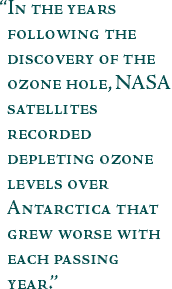

From Observing to Measuring Changes on Earth | |||
Altogether, NASA launched a total of seven Landsats, the most recent—Landsat 7—was launched in April 1999. It and Landsat 5 are the only two of that series currently in operation. Since the first Landsat mission, the series' primary objective has been to measure changes on the land surface at high resolution. Whereas the first Landsat could collect images at about 65 meters per pixel (at nadir), Landsat 7 can see the surface at resolutions as fine as 15 meters per pixel. Such detailed imagery allows scientists to find geologic features such as meteor impact craters previously undiscovered. Additionally, because healthy green plants reflect and absorb infrared light differently than dry brown plants, scientists found they could use Landsat data to monitor the health of croplands and forestlands over large areas. Landsat also provides an excellent data set for gauging the rates of deforestation, drying inland water bodies, expanding desert regions, and sprawling urban centers. Researchers around the world routinely use Landsat data for these and myriad other applications.
In 1973, two researchers at the University of California, Irvine, published their theory that man-made chlorofluorocarbons (CFCs) could damage the Earth's stratospheric ozone shield. Two years later, Congress asked NASA to develop a "comprehensive program of research, technology, and monitoring of phenomena of the upper atmosphere." In particular, Congress' intent was to ascertain the "health" of the ozone layer. In 1978, NASA launched the last of the Nimbus spacecraft series—Nimbus 7—carrying two new sensors called the Solar Backscatter Ultraviolet (SBUV) instrument and the Total Ozone Mapping Spectrometer (TOMS). Sensitive to radiant energy in the ultraviolet region of the electromagnetic spectrum, the Nimbus 7 sensors took advantage of the fact that molecules and aerosol particles reflect certain wavelengths of ultraviolet rays while ozone absorbs others at different levels in the atmosphere. By analyzing the amount of ultraviolet energy reflected back up to the spacecraft, researchers could produce profiles of how thick or thin the ozone was at different altitudes and locations. But, ironically, the ozone "hole" over Antarctica wasn't discovered until May 1985, when a British researcher using a ground-based Dobson ozone spectrophotometer found that stratospheric ozone over Halley Bay was about 40 percent less than what had been measured during the previous winter. Surprised, NASA researchers hastily reviewed their TOMS data and found that it too had detected a dramatic loss of ozone over all of Antarctica. Why hadn't they discovered the phenomenon earlier? Unfortunately, the TOMS data analysis software had been programmed to flag and set aside data points that deviated greatly from expected measurements and so the initial measurements that should have set off alarms, perhaps years earlier, were simply overlooked. In short, the TOMS team failed to detect the ozone hole because it was much more severe than scientists expected.
In the years following the discovery of the ozone hole, NASA satellites recorded depleting ozone levels over Antarctica that grew worse with each passing year. In response, in 1987, 43 nations signed the "Montreal Protocol" in which they agreed to reduce the use of CFCs by 50 percent by the year 2000. In 1991, NASA's Upper Atmosphere Research Satellite (UARS) mapped levels of chlorine monoxide in the stratosphere and quickly demonstrated that there is a direct link between the presence of chlorine, the formation of chlorine monoxide during winter in the Southern Hemisphere, and the destruction of ozone. Was a global disaster averted? Will levels of stratospheric ozone stabilize and return to normal in the coming years? We don't know yet, only time and more data will tell. next: Towards Predicting Climate Change
|
 Space-based Observations of the Earth Introduction
| ||